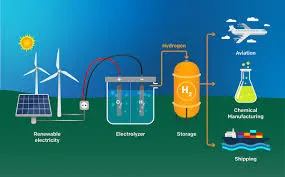
-
The 2023 United Nations Climate Change Conference (COP28) emphasizes transitioning from fossil fuels, particularly crucial for countries like India with heavy energy imports.
-
Green hydrogen, produced through water electrolysis using renewable energy, is a key solution for energy storage and zero-emission industrial feedstock.
-
Despite hydrogen’s potential, current production emits a significant amount of CO2; green hydrogen is a cleaner alternative.
-
Green hydrogen’s cost must decrease for widespread adoption
-
Businesses are adopting biofuels and renewables for net-zero goals; green hydrogen and its derivatives (methanol, ammonia) are potential solutions for heavy-duty transportation.
-
Green hydrogen’s cost needs to drop from $3-5 to $1 per kilogram for broad acceptance, making it economically viable for various sectors.
-
Policy and international efforts are introduced to fast-track green hydrogen adoption, including permitting, demand aggregation, incentives, and mandates.
-
Vertical integration at scale, encompassing the entire supply chain, is crucial for cost reduction, but it requires significant capital and carries risks.
-
Early experimentation, infrastructure investment, and technological improvements are needed for green hydrogen-based decarbonization solutions.







